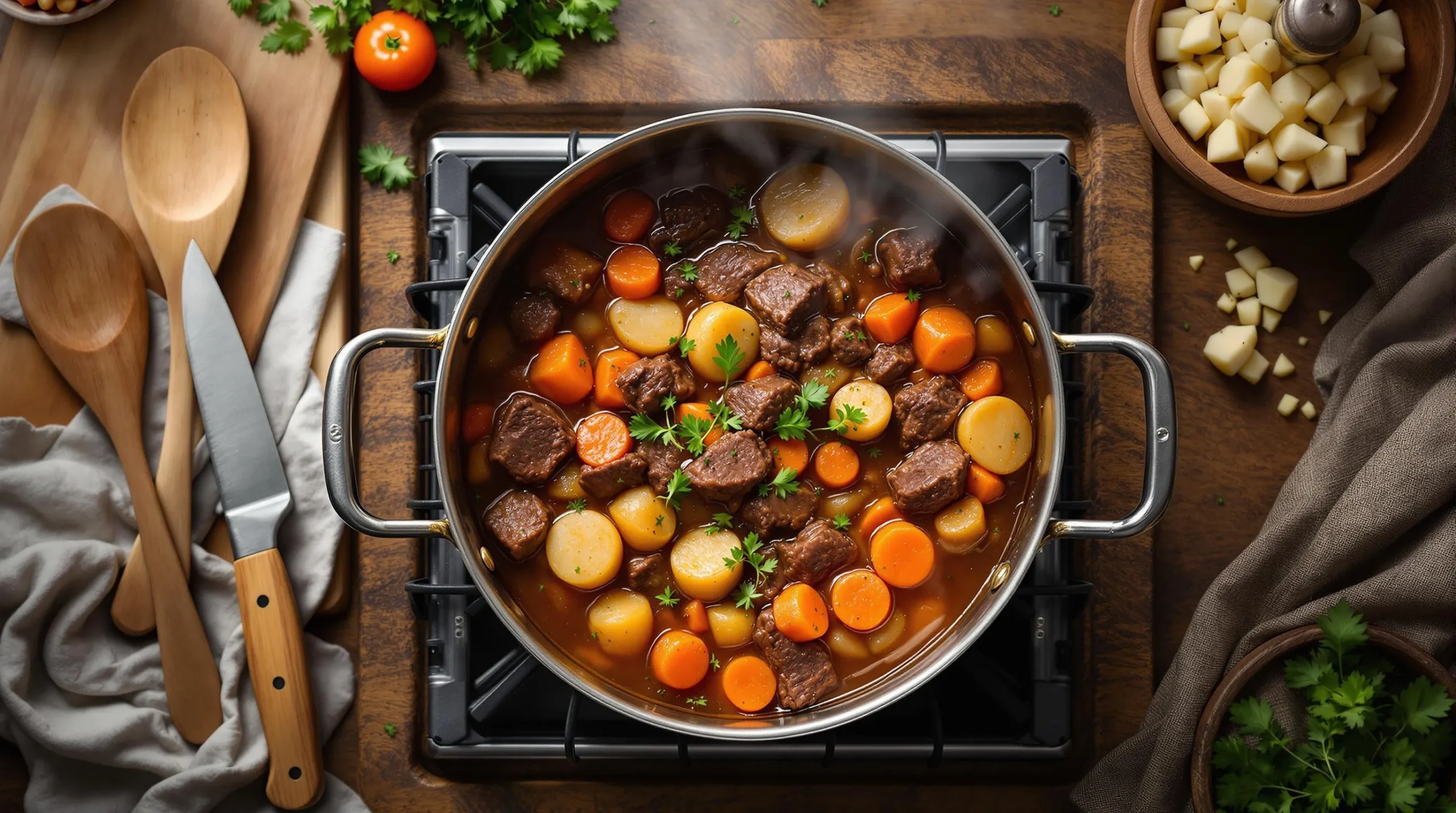Why This Beef Stew Recipe Is a Family Favorite
This beef stew recipe has earned its place at our family table for countless reasons. The magic begins with its incredible depth of flavor that develops as it simmers slowly on the stovetop. Each bite delivers tender chunks of beef that practically melt in your mouth after cooking in that rich savory broth.
Your family will appreciate how this recipe transforms affordable cuts of meat into something truly special. The humble chuck roast becomes extraordinarily tender when given enough time to break down properly in the cooking process.
Everyone loves the beautiful balance of ingredients – the earthy potatoes the sweet carrots and the aromatic herbs all working together to create a harmonious dish. The consistency is perfect too – not too thin like a soup but not too thick either just right for sopping up with crusty bread.
Kids particularly enjoy the approachable flavors while adults appreciate the sophisticated layers of taste. You’ll find this stew actually improves with time making leftovers even more delicious than the first serving.
The versatility of this recipe allows you to adapt it to your family’s preferences without losing its essential character. Add more vegetables swap in different herbs or adjust the thickness of the gravy to make it uniquely yours.
During cold winter months nothing brings comfort quite like a steaming bowl of this hearty stew. Its warming properties extend beyond just temperature – there’s something emotionally nourishing about sharing this meal together around the table.
Key Ingredients for the Perfect Beef Stew
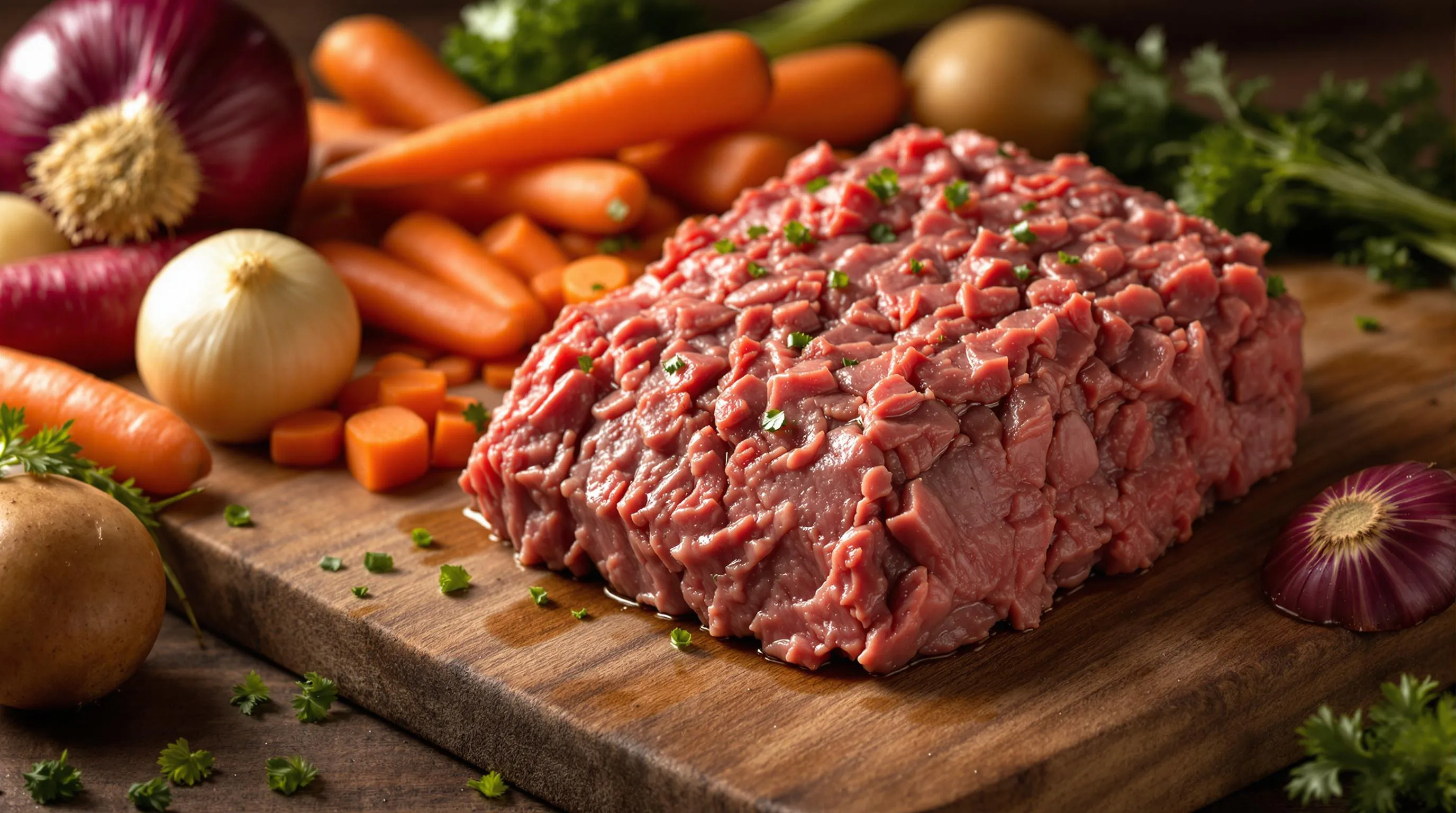
Creating an exceptional beef stew relies on selecting the right ingredients that work together to build layers of flavor. The following components form the foundation of a rich and satisfying stew that will have everyone asking for seconds.
Best Cuts of Beef for Stew
Chuck roast stands as the premier choice for beef stew due to its perfect balance of fat marbling and connective tissue that breaks down during slow cooking. You’ll find this affordable cut transforms into melt-in-your-mouth tender morsels after a few hours of gentle simmering. Bottom round and brisket also work wonderfully as they contain enough collagen to create that silky mouthfeel characteristic of great stews. Avoid leaner cuts like sirloin or tenderloin which tend to become tough and dry when cooked for extended periods. Look for meat with good marbling and cut it into uniform 1-inch cubes to ensure even cooking throughout your stew.
Fresh Vegetables That Add Depth
Aromatic vegetables form the flavor foundation of any exceptional beef stew. Begin with the classic mirepoix of onions carrots and celery which provides the essential base notes. Potatoes serve dual purposes by adding heartiness and naturally thickening the broth as they cook. Mushrooms deliver earthiness and umami while parsnips contribute subtle sweetness that balances the savory elements. For additional complexity consider adding pearl onions turnips or sweet potatoes which each bring unique characteristics to the final dish. Fresh vegetables should be cut into chunks larger than the beef as they cook more quickly and will maintain their integrity throughout the long cooking process.
Herbs and Seasonings
Bay leaves thyme and rosemary form the classic herb trio that elevates beef stew from ordinary to extraordinary. You should use fresh herbs when possible but dried herbs work effectively when added early in the cooking process. Garlic provides essential aromatic qualities while tomato paste contributes acidity and depth. Worcestershire sauce adds complexity with its fermented umami notes that enhance the beef’s natural flavors. For depth and richness incorporate red wine or beef broth as your cooking liquid. Season judiciously with salt and black pepper throughout the cooking process rather than all at once. Fresh parsley added just before serving brings brightness that cuts through the richness of the finished stew.
Equipment Needed
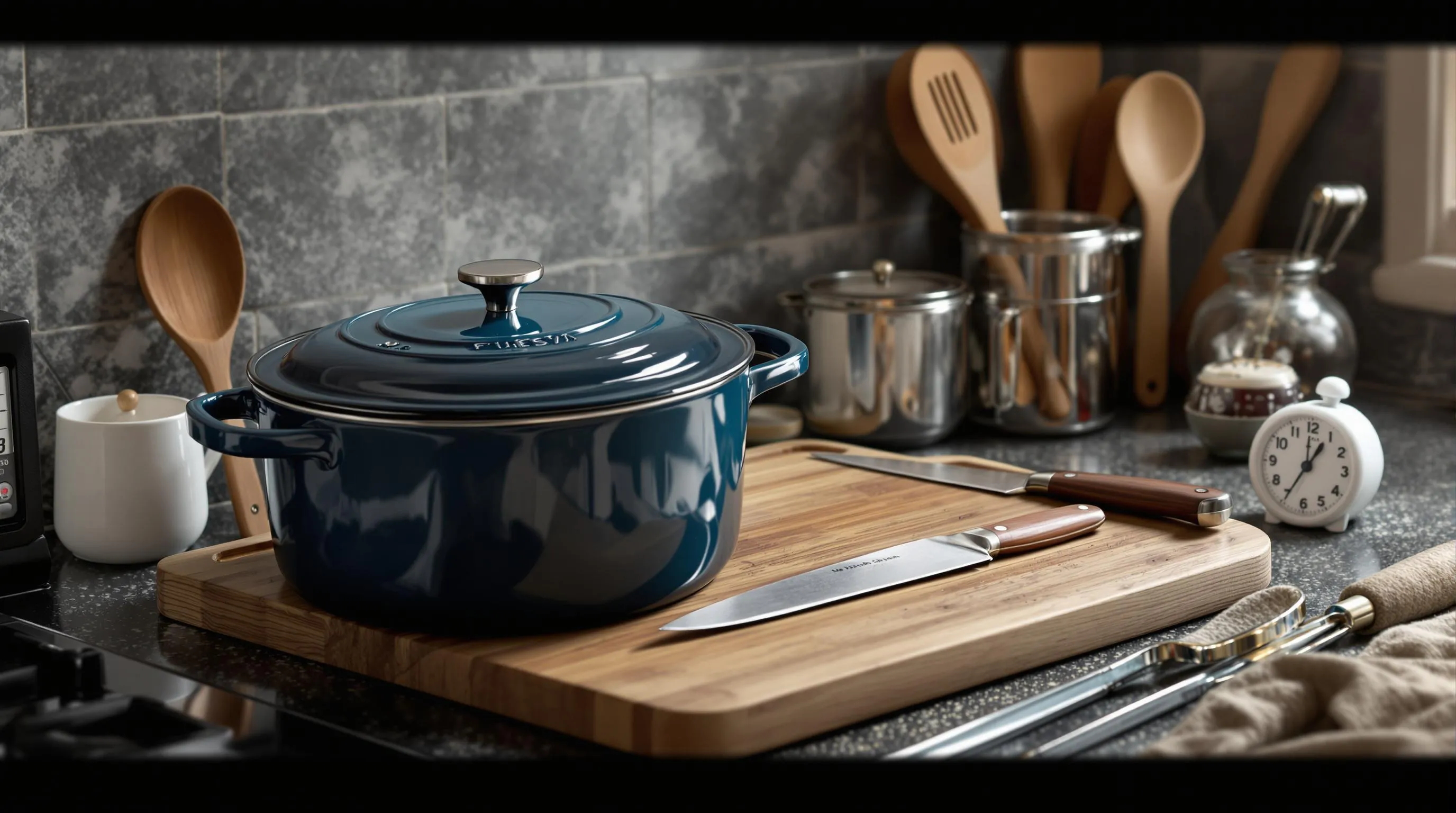
Creating perfect beef stew requires just a few essential kitchen tools that make the cooking process smooth and efficient. Here’s what you’ll need:
- Dutch oven (5-7 quart size) – The ideal vessel for beef stew with its heavy bottom and tight-fitting lid that distributes heat evenly
- Sharp chef’s knife – For cutting beef into uniform chunks and dicing vegetables
- Cutting board – Preferably wooden or plastic with grooves to catch meat juices
- Measuring cups and spoons – For accurate ingredient measurements
- Wooden spoon or heat-resistant spatula – For stirring and scraping up flavorful brown bits from the pot bottom
- Tongs – Helpful for turning meat pieces when browning
- Kitchen timer – To track cooking times accurately
Your Dutch oven serves as the workhorse for this recipe with its ability to move from stovetop to oven if needed. The heavy construction maintains consistent temperature while the tight lid traps moisture during the long simmering process. Many home cooks prefer enameled cast iron Dutch ovens because they prevent reactive interactions with acidic ingredients like tomato paste and wine.
When selecting your knife for this recipe ensure it’s sharp enough to cut through raw beef cleanly. Dull knives require more force and create ragged edges that can affect how evenly your meat cooks. Your wooden spoon should be sturdy enough to handle the weight of the stew when stirring.
Most beef stew recipes don’t require specialized equipment which makes this hearty dish accessible for cooks of all experience levels. The straightforward tools listed above transform simple ingredients into a rich satisfying meal that improves with each passing hour as it simmers.
Ingredients
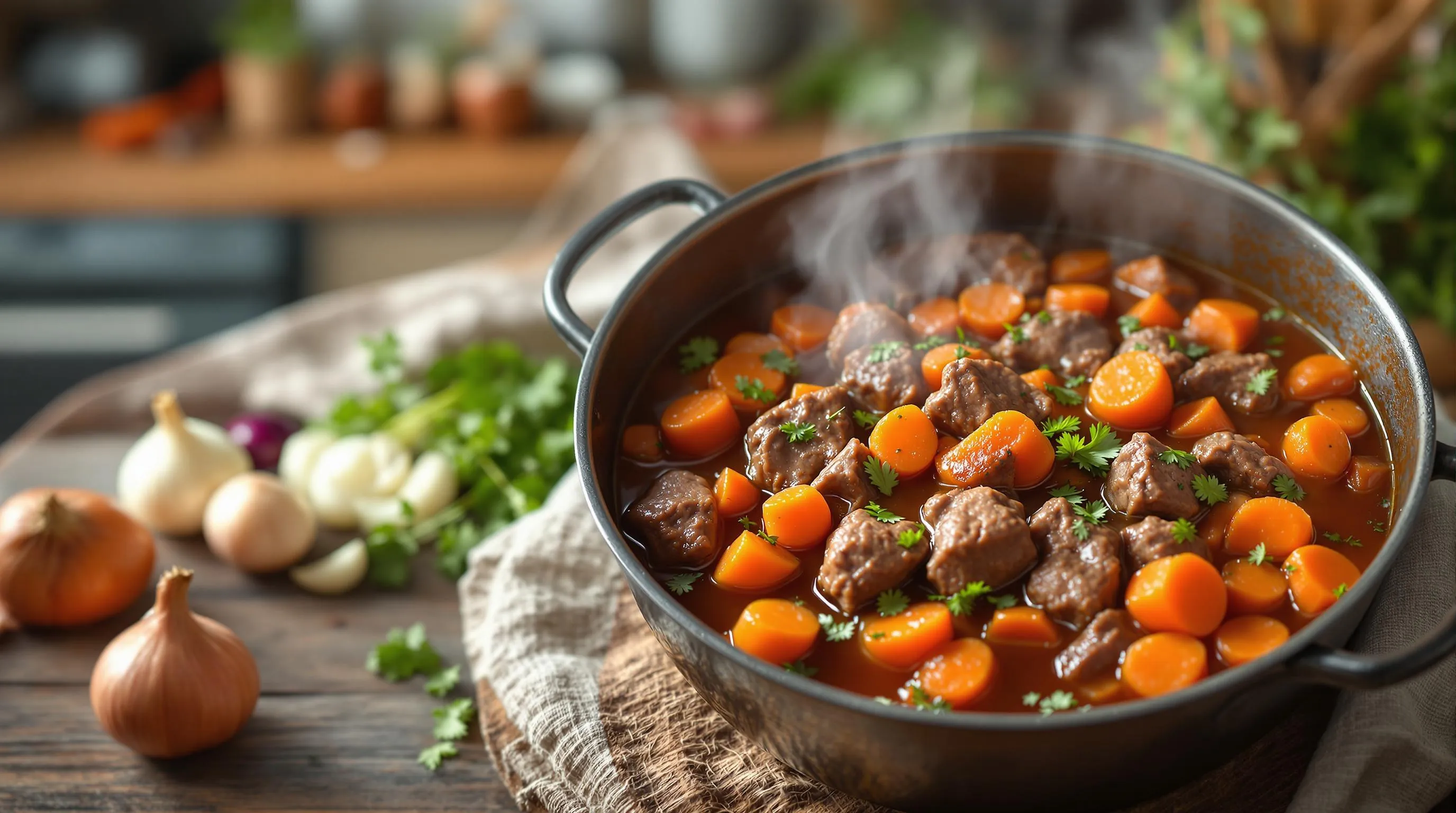
For this classic beef stew recipe, gather these essential ingredients that work together to create deep, rich flavor:
For the Meat Base:
- 2 pounds chuck roast, cut into 1-inch cubes
- 2 tablespoons vegetable oil
- 2 tablespoons all-purpose flour
- 1 teaspoon salt
- ½ teaspoon freshly ground black pepper
Aromatics and Vegetables:
- 1 large yellow onion, chopped
- 3 cloves garlic, minced
- 2 tablespoons tomato paste
- 4 medium carrots, peeled and cut into chunks
- 2 stalks celery, diced
- 1 pound baby potatoes, halved (or larger potatoes cut into chunks)
- 8 ounces mushrooms, quartered (optional)
Liquids and Seasonings:
- 1 cup dry red wine (or additional beef broth)
- 4 cups beef broth
- 2 bay leaves
- 3 sprigs fresh thyme (or 1 teaspoon dried)
- 1 sprig fresh rosemary (or ½ teaspoon dried)
- 1 tablespoon Worcestershire sauce
For Finishing:
- ¼ cup fresh parsley, chopped
- Salt and pepper to taste
Your beef stew will develop its signature flavor from this careful balance of ingredients. Quality matters particularly for the beef and broth which form the foundation of your stew. Store-bought beef broth works perfectly well but homemade stock takes this dish to another level if you have it available. All these components simmer together to create that soul-warming meal your family will request again and again.
Preparation

Creating the perfect beef stew requires methodical preparation that builds flavor at every stage. Follow these steps to ensure your stew turns out rich, hearty, and delicious.
Preparing the Beef
Start by removing your chuck roast from the refrigerator about 30 minutes before cooking to bring it to room temperature. Pat the meat completely dry with paper towels to ensure proper browning. Trim away any excessive fat while leaving some marbling intact for flavor development. Cut the beef into uniform 1½-inch cubes—this size allows the meat to retain moisture while becoming tender during the long cooking process. Season the cubes generously with salt and freshly ground black pepper. Toss the seasoned beef in flour until lightly coated, shaking off any excess. This flour coating will help develop a rich brown crust and later thicken your stew. Heat vegetable oil in your Dutch oven until shimmering before adding the beef in batches. Overcrowding the pan prevents proper browning, so maintain space between pieces and work in 2-3 batches for best results. Brown each side for about 2-3 minutes until you achieve a deep caramelization that will infuse your stew with robust flavor.
Chopping the Vegetables
Prepare your vegetables while the beef browns to streamline the cooking process. Peel and dice onions into ½-inch pieces—these will practically dissolve during cooking, creating a sweet foundation for your stew. Wash and peel carrots before cutting them into hearty 1-inch chunks that maintain their shape and provide textural contrast. Trim the ends from celery stalks and slice them into ½-inch pieces, which will contribute subtle flavor to the broth. Scrub potatoes thoroughly under cold water, leaving the skins on for rustic texture and added nutrients, then cut them into 1½-inch cubes. Quarter mushrooms if using them—they’ll shrink considerably during cooking while adding earthy depth. Mince garlic cloves finely to ensure they distribute evenly throughout the stew. Prepare any additional vegetables like parsnips or turnips using similar sizing principles to ensure even cooking. Store your prepped vegetables separately since they’ll be added to the pot at different times according to their cooking requirements.
Cooking Instructions

Follow these step-by-step instructions to transform your simple ingredients into a hearty beef stew with deep flavor and tender meat. This foolproof method ensures perfect results every time.
Browning the Meat
Heat 2 tablespoons of vegetable oil in your Dutch oven over medium-high heat until shimmering. Work in batches adding only enough beef cubes to cover the bottom of the pot without overcrowding. Allow each piece to sear undisturbed for 3-4 minutes until a deep brown crust forms. Turn each piece and brown on all sides then transfer to a plate. Continue with remaining beef adding more oil if needed. This crucial step creates the foundation of flavor through the Maillard reaction developing those complex savory notes that make your stew exceptional. Resist the urge to stir constantly as proper browning requires direct contact with the hot surface.
Building the Flavor Base
Return the Dutch oven to medium heat and add chopped onions to the beef drippings. Cook for 4-5 minutes until they begin to soften and turn translucent. Add minced garlic and cook for 30 seconds until fragrant being careful not to burn it. Stir in 2 tablespoons of tomato paste cooking for 1-2 minutes until it darkens slightly and coats the onions. Pour in 1 cup of red wine or additional beef broth scraping the bottom of the pot with a wooden spoon to release all those flavorful browned bits. The liquid will begin to reduce creating an intensely flavored base for your stew. Add carrots and celery cooking for another 3 minutes to soften slightly.
Simmering to Perfection
Return browned beef to the pot along with any accumulated juices. Pour in 4 cups of beef broth making sure the meat is just barely covered adding more if needed. Add bay leaves thyme sprigs and a tablespoon of Worcestershire sauce. Bring the mixture to a gentle boil then reduce heat to maintain a low simmer. Cover partially leaving a small gap for steam to escape. Let the stew simmer for 1½ hours stirring occasionally until the beef begins to become tender. Add cubed potatoes and continue simmering for 30-45 minutes more until both meat and vegetables are fork-tender. The liquid should thicken naturally but if you prefer a thicker stew you can make a slurry with 2 tablespoons each of flour and cold water whisking it into the pot during the final 15 minutes of cooking. Taste and adjust seasoning with salt and pepper before serving your perfectly simmered beef stew.
Serving Suggestions
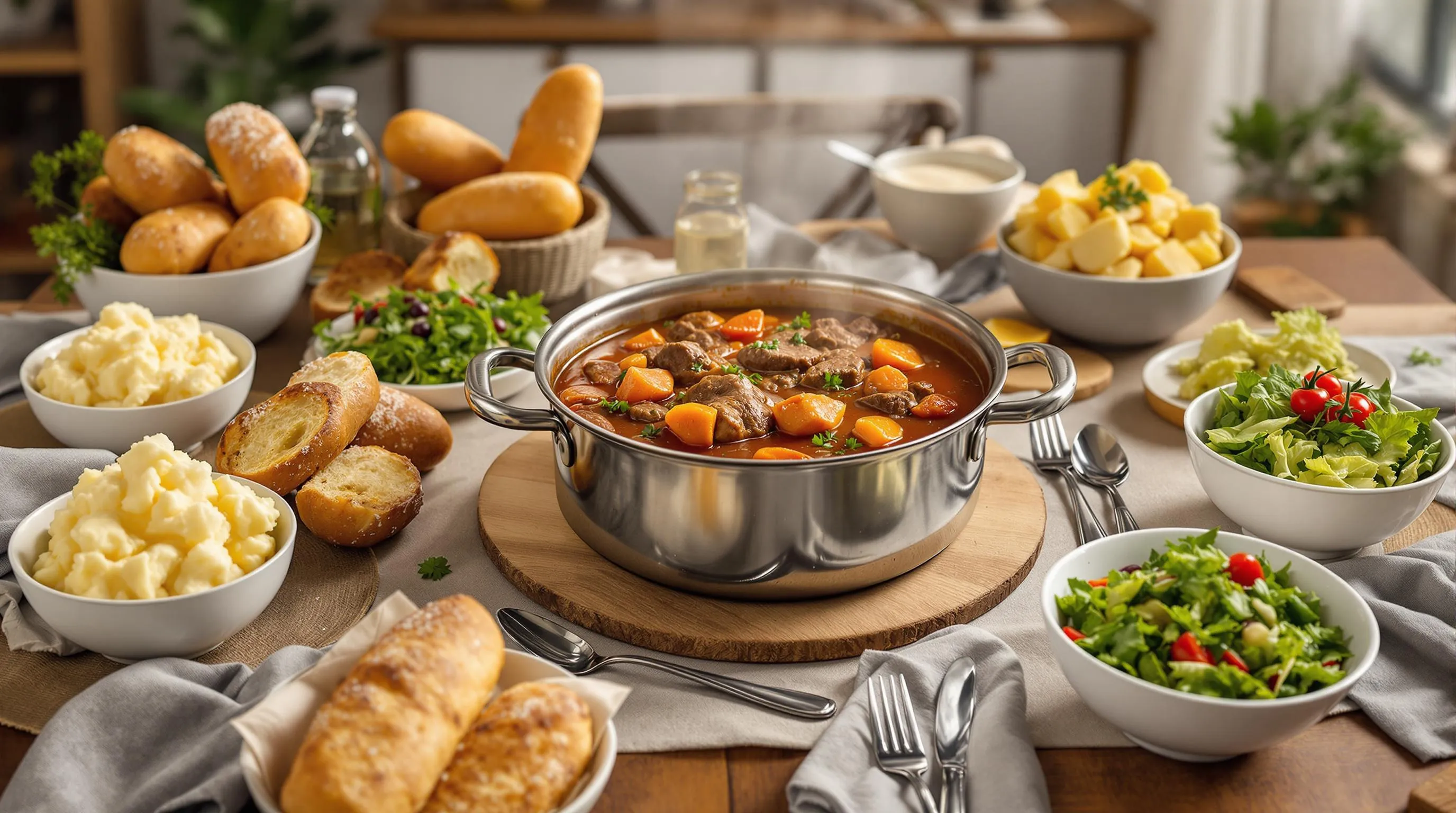
Transform your beef stew from a simple meal into a memorable dining experience with these complementary serving ideas. A hearty beef stew stands perfectly on its own but truly shines when paired with the right accompaniments.
Crusty bread serves as the ultimate partner for beef stew. Choose a rustic French baguette or homemade sourdough to soak up every last drop of that rich gravy. Artisanal bread with a crackling crust and tender interior provides the perfect textural contrast to the tender beef and vegetables.
Mashed potatoes create a velvety bed for your stew. Spoon the rich beef mixture over a cloud of buttery mashed potatoes for the ultimate comfort food combination. This pairing works especially well if you’ve made your stew without potatoes inside.
Fresh green salads balance the richness of beef stew beautifully. Try a simple arugula salad with lemon vinaigrette or a classic Caesar to cut through the hearty flavors. The bright acidity and crisp textures offer a refreshing counterpoint to the savory stew.
Roasted vegetables make an excellent side dish when you want to add more nutrition to your meal. Consider roasting Brussels sprouts carrots or parsnips tossed with olive oil and herbs until caramelized. These vegetables complement the flavors in your stew without competing with them.
Steamed rice serves as a neutral base that soaks up the savory broth. White rice jasmine rice or even wild rice blends work wonderfully with beef stew particularly if your recipe has Asian or international influences.
Wine pairings elevate your beef stew experience significantly. Full-bodied red wines like Cabernet Sauvignon Malbec or Syrah mirror and enhance the rich flavors in your stew. The tannins in these wines pair particularly well with the tender beef.
For family-style serving consider placing the Dutch oven directly on the table (with a trivet underneath). This casual presentation keeps the stew hot throughout the meal and creates a communal dining atmosphere that encourages conversation and connection.
Individual bowls work best for more formal settings. Pre-warm your serving bowls by filling them with hot water for a few minutes then emptying and drying before ladling in the stew. This simple step ensures your stew stays hot from the first bite to the last.
Garnish each serving with a sprinkle of fresh herbs like parsley thyme or chives to add color and a burst of fresh flavor. A dollop of sour cream or crème fraîche adds richness and visual appeal to each bowl.
Storage and Reheating Tips
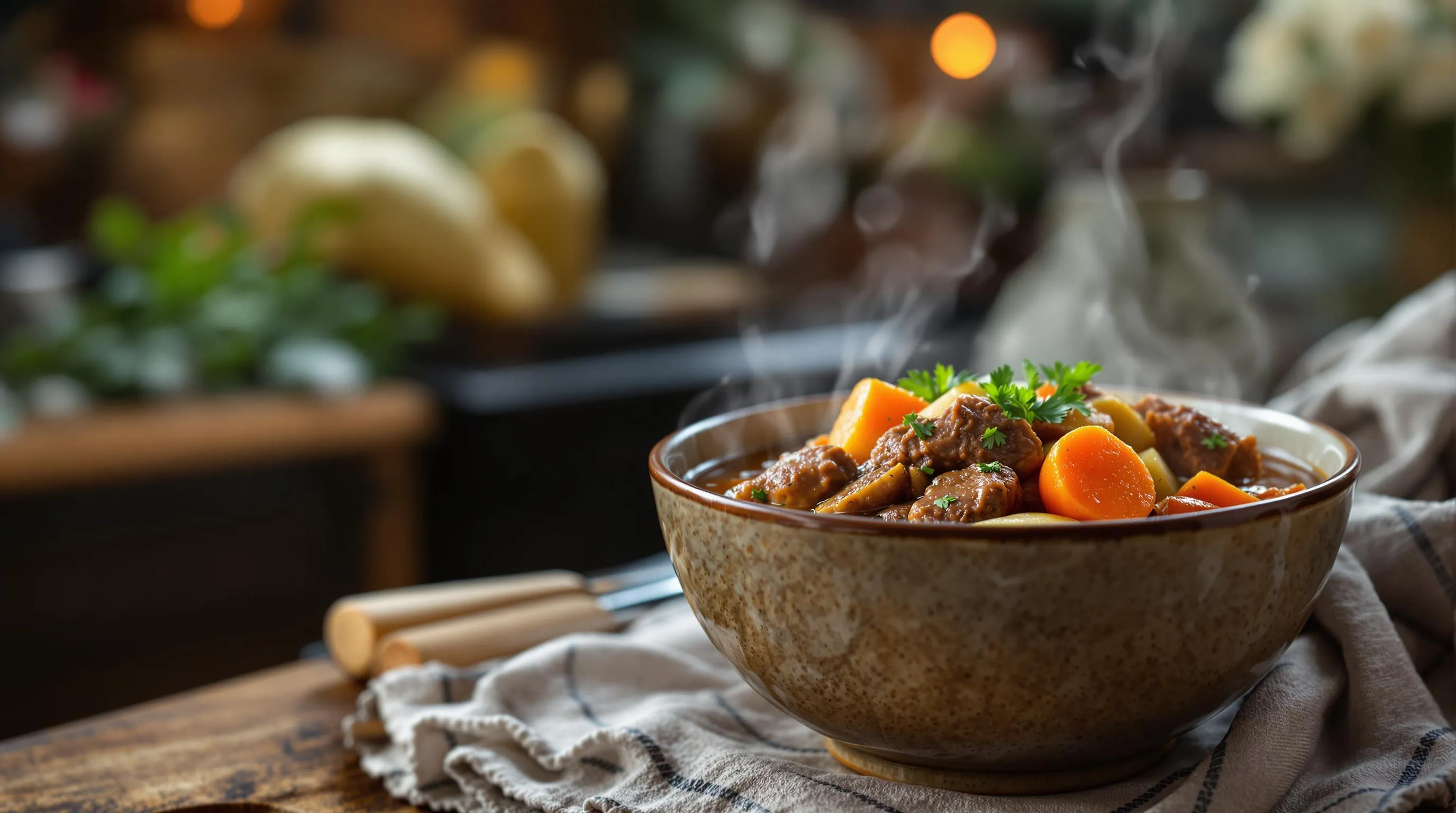
Beef stew tastes even better the next day as the flavors continue to develop and meld together. Proper storage and reheating techniques ensure you can enjoy your delicious stew for days after cooking.
Refrigerating Leftover Beef Stew
Allow your beef stew to cool completely before transferring to airtight containers. Store in the refrigerator for up to 4 days for optimal freshness and flavor. The stew will naturally thicken when chilled due to the gelatin released from the meat during cooking. Divide leftovers into portion-sized containers if you plan to reheat individual servings.
Freezing for Later Use
Beef stew freezes exceptionally well making it perfect for meal prep. Pour cooled stew into freezer-safe containers leaving about 1 inch of headspace to allow for expansion. You can also use heavy-duty freezer bags laid flat for space-efficient storage. Label containers with the date and contents to track freshness. Properly stored beef stew maintains quality in the freezer for up to 3 months.
Best Reheating Methods
Stovetop Method: Place your desired amount of stew in a pot over medium-low heat. Add a splash of beef broth if the stew seems too thick. Stir occasionally until heated through (165°F) usually taking 10-15 minutes depending on quantity.
Microwave Method: Transfer a single serving to a microwave-safe bowl. Cover with a microwave-safe lid or plate leaving a small vent. Heat on 70% power for 2 minutes then stir and continue heating in 1-minute intervals until thoroughly hot.
Oven Method: Preheat your oven to 325°F. Transfer stew to an oven-safe dish and cover with foil. Heat for approximately 30 minutes or until the internal temperature reaches 165°F stirring halfway through.
Revitalizing Leftover Stew
Refresh day-old stew by adding fresh herbs just before serving. A splash of Worcestershire sauce or balsamic vinegar can brighten flavors that may have mellowed during storage. If the stew has thickened too much during storage stir in additional beef broth until you reach your desired consistency. Consider adding freshly cooked vegetables like peas or green beans to introduce new textures and flavors to leftover stew.
Food Safety Considerations
Never leave beef stew at room temperature for more than 2 hours. Reheat leftover stew thoroughly to an internal temperature of 165°F to ensure food safety. Use clean utensils each time you serve from refrigerated leftovers to prevent contamination. Discard any stew that shows signs of spoilage including off odors unusual appearance or slimy texture.
Make-Ahead Instructions
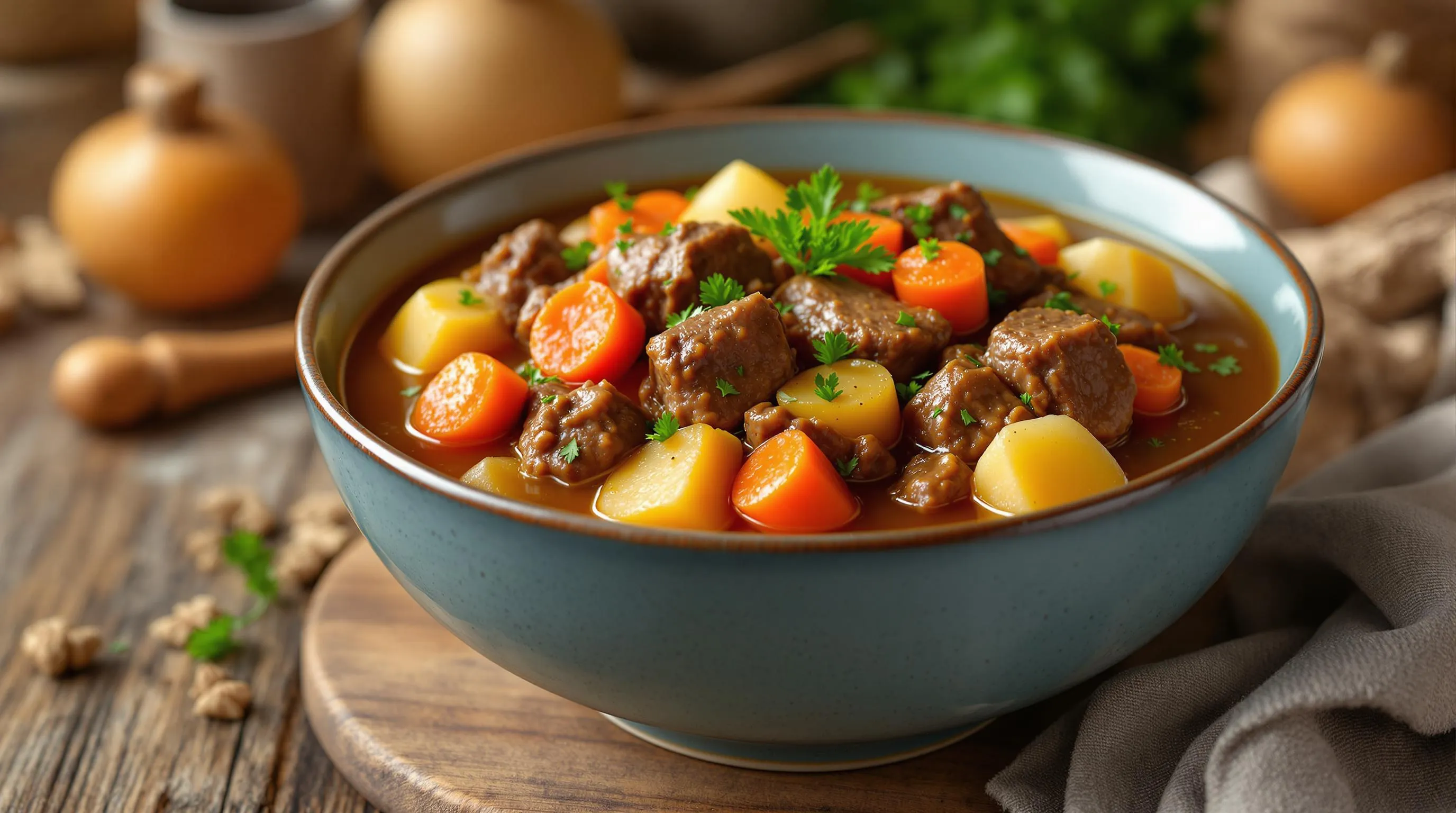
Beef stew shines as a perfect make-ahead meal since its flavors actually improve with time. You can prepare this hearty dish up to 3 days before serving by following these simple strategies.
Cook the stew completely according to the recipe then allow it to cool to room temperature before transferring to airtight containers. Store in the refrigerator where the flavors will continue to develop and meld together creating an even more delicious result.
For longer advance preparation consider these approaches:
- Prep-Only Method: Cut and season the beef then chop all vegetables up to 24 hours ahead. Store meat and vegetables separately in airtight containers in the refrigerator to streamline cooking day.
- Partial Cooking Method: Complete the browning of meat and sautéing of aromatics then refrigerate this base. Finish the cooking process with remaining ingredients the next day cutting your active cooking time significantly.
- Complete and Freeze: Fully cook your stew let it cool completely then freeze in freezer-safe containers for up to 3 months. Thaw overnight in the refrigerator before reheating.
When reheating make-ahead stew use gentle heat on the stovetop adding a splash of broth if needed to restore desired consistency. Taste and adjust seasonings before serving as some flavors may intensify during storage.
Add delicate ingredients like fresh herbs only upon final reheating to maintain their bright flavors and colors. This make-ahead flexibility makes beef stew ideal for entertaining or meal planning without sacrificing quality or taste.
Variations to Try
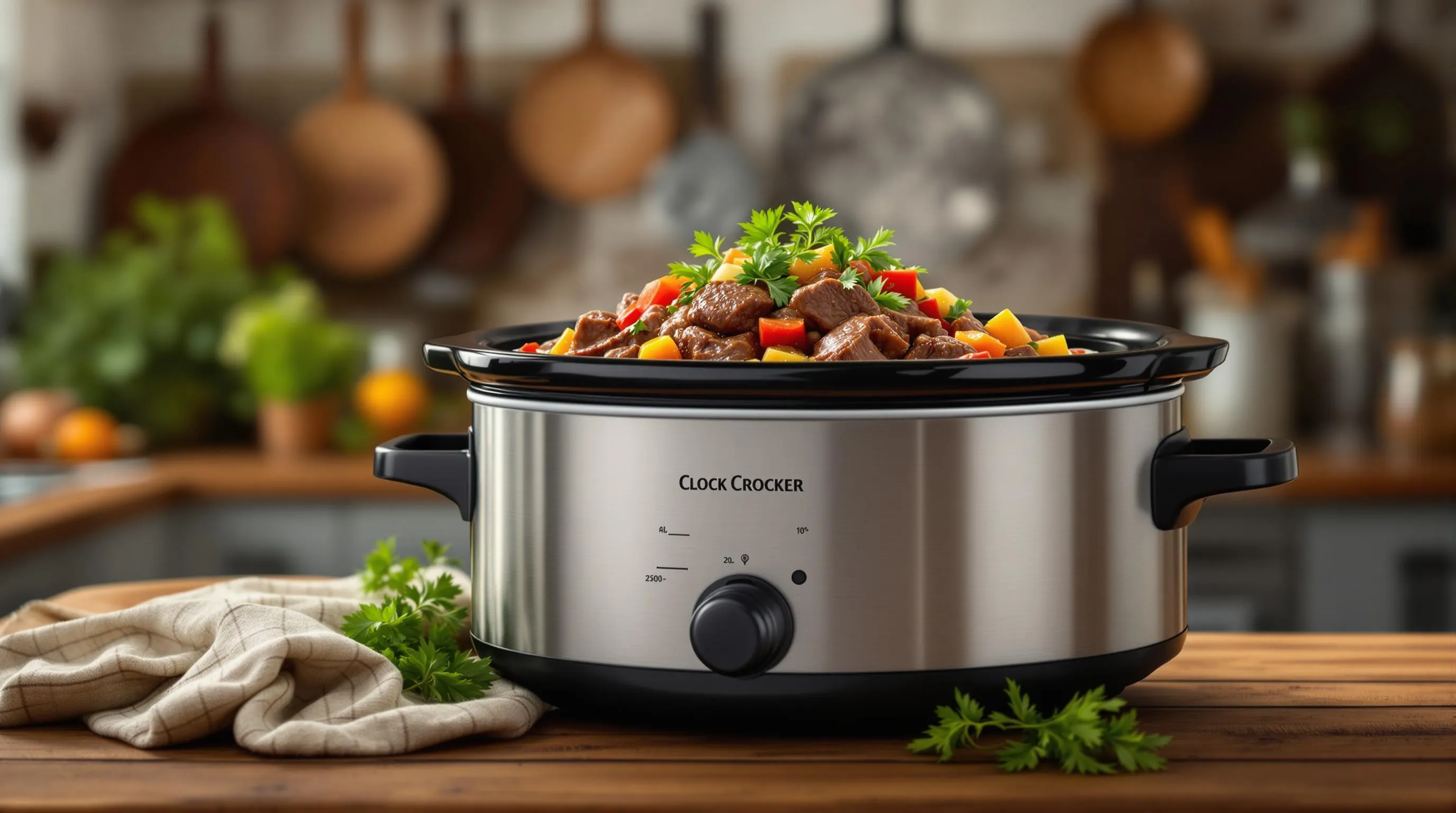
Once you’ve mastered the classic beef stew recipe you can explore these delicious variations that adapt the traditional method to different cooking techniques and flavor profiles. Each variation maintains the soul-warming essence of beef stew while offering unique twists.
Slow Cooker Beef Stew
Transform your beef stew into a hands-off meal by adapting it for a slow cooker. Brown the beef chunks on the stovetop first to develop that crucial flavor foundation before transferring to your slow cooker. Add your vegetables carrots potatoes onions and mushrooms along with broth herbs and seasonings. Set your slow cooker to low for 8-10 hours or high for 4-5 hours until the beef is fork-tender. The gentle constant heat of a slow cooker breaks down tough connective tissues perfectly resulting in exceptionally tender meat. For the best texture add potatoes during the last 2-3 hours of cooking to prevent them from becoming too soft. This method is perfect for busy weekdays when you want to return home to a ready-to-serve meal with minimal effort.
Instant Pot Method
Speed up your beef stew preparation without sacrificing flavor by using an Instant Pot or pressure cooker. Use the sauté function to brown the beef chunks and sauté aromatics directly in the pot. Add your remaining ingredients including broth vegetables and seasonings then secure the lid and set to high pressure for 35 minutes. Allow for a 10-minute natural pressure release followed by a quick release. The pressure cooking method reduces cooking time dramatically while still achieving that melt-in-your-mouth beef texture. For thicker stew after pressure cooking select the sauté function again and simmer uncovered for 5-10 minutes. This method delivers all the depth and richness of slow-cooked beef stew in about an hour making it perfect for last-minute dinner plans.
Wine-Enriched Beef Stew
Elevate your beef stew with a generous addition of red wine for a more complex flavor profile. Replace about half of your beef broth with a dry red wine such as Cabernet Sauvignon Merlot or Burgundy. The wine introduces tannic structure and fruity notes that complement the richness of the beef beautifully. Add the wine after browning the meat and deglaze the pot scraping up all the flavorful browned bits from the bottom. Let the wine reduce by half before adding the remaining ingredients to concentrate its flavor and cook off most of the alcohol. Include additional aromatics like shallots instead of onions and perhaps some fresh thyme sprigs for a French-inspired twist reminiscent of Beef Bourguignon. This sophisticated variation pairs wonderfully with crusty bread and makes an impressive dish for dinner parties or special occasions.
Troubleshooting Your Beef Stew
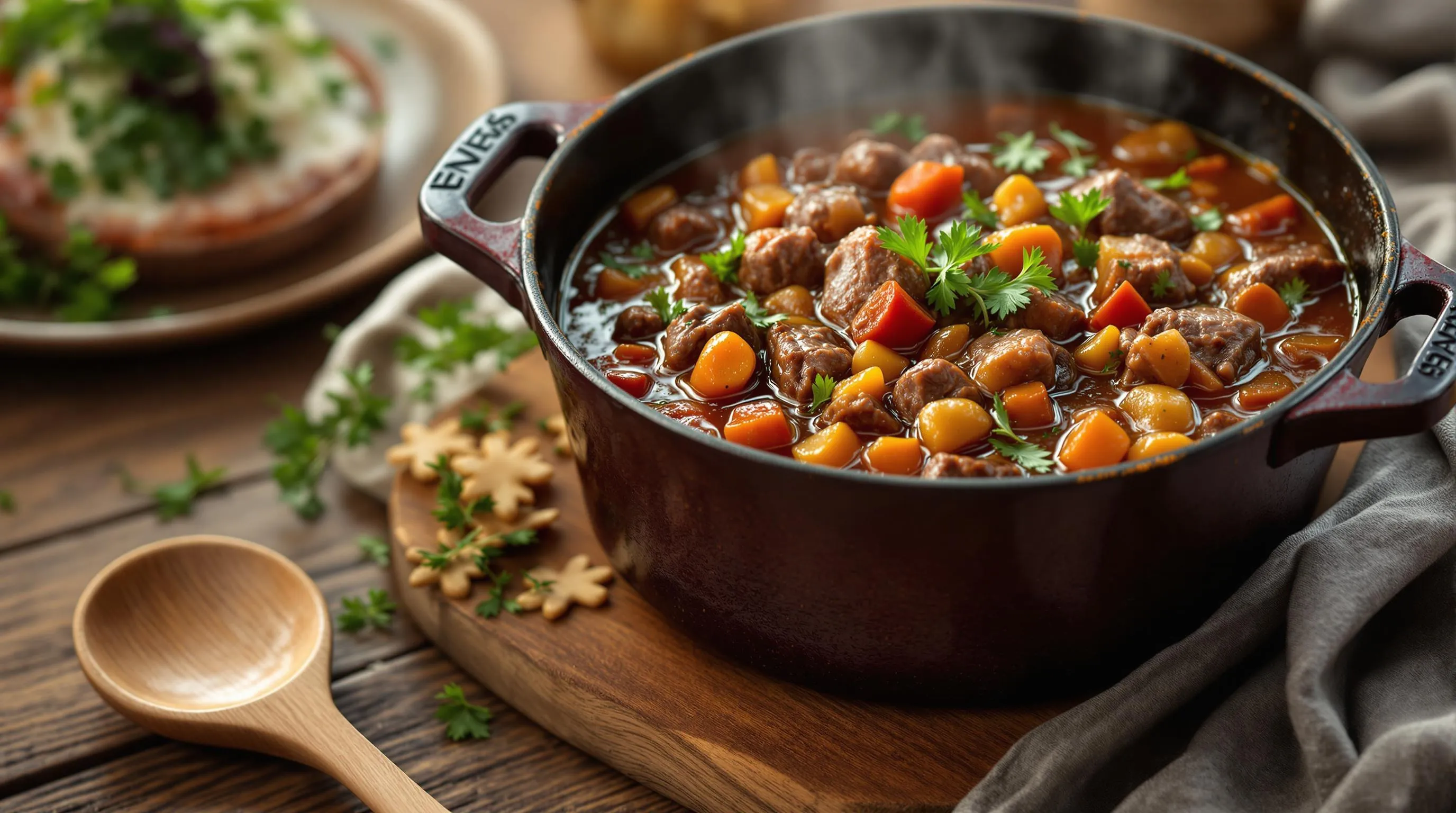
Even experienced cooks occasionally encounter challenges when making beef stew. Identifying common issues and knowing how to fix them ensures your stew turns out perfectly every time.
Tough Meat
Beef remains tough even though long cooking? This typically indicates insufficient cooking time. Continue simmering until the meat falls apart easily with a fork. Some cuts require up to 3 hours to fully tenderize. Using the wrong cut of beef can also cause toughness – always select well-marbled chuck roast or similar cuts with connective tissue that breaks down during slow cooking. Cutting meat pieces too large extends cooking time substantially – aim for uniform 1-inch cubes for even cooking.
Watery Stew
A thin or watery consistency disappoints when you’re expecting rich heartiness. Create a flour slurry by mixing 2 tablespoons all-purpose flour with ¼ cup cold water until smooth then stir this into your simmering stew. Allow it to cook for 10-15 minutes to thicken properly. Alternatively remove the lid during the final 30 minutes of cooking to reduce liquid through evaporation. For immediate results scoop out ½ cup of cooking liquid mix with 1 tablespoon cornstarch and return to the pot.
Too Salty
Oversalting happens easily especially when using store-bought broth. Dilute the saltiness by adding more unsalted liquid such as water or unsalted beef broth. A peeled potato added to the stew for 30 minutes can absorb excess salt (remove before serving). Balancing with acid helps – try a splash of vinegar or lemon juice which counters saltiness while brightening flavors.
Bland Flavor
Underwhelming flavor indicates insufficient seasoning or inadequate development of flavor foundations. Enhance taste with umami-rich ingredients like tomato paste Worcestershire sauce or mushrooms. Add herbs toward the end of cooking for fresher flavor impact. Consider deglazing your pan properly after browning meat to capture all those flavorful brown bits. Taste and adjust seasonings near the end of cooking when flavors have developed.
Vegetables Too Soft or Too Firm
Mushy vegetables result from adding them too early in the cooking process. Add hardy vegetables like carrots and potatoes during the last 30-45 minutes of cooking. Reserve delicate vegetables like peas for the final 10 minutes. Conversely firm vegetables indicate insufficient cooking time – test with a fork for desired tenderness before serving. Different vegetables require different cooking times which is why staggered additions produce the best texture results.
Greasy Surface
An oily film floating on top occurs when using fattier cuts without proper trimming. Skim the surface with a large spoon or ladle before serving. For make-ahead stews refrigerate overnight then remove the solidified fat layer before reheating. Alternatively use a fat separator when transferring the finished stew from pot to serving dish.
Burning on the Bottom
Scorching typically happens when heat is too high or liquid is insufficient. Always maintain a gentle simmer rather than a boil. Stir occasionally especially toward the bottom of the pot where burning occurs first. Using a heavy-bottomed pot like a Dutch oven distributes heat more evenly preventing hot spots. Add additional liquid if the stew becomes too thick during cooking.
Nutritional Information
Understanding the nutritional content of this hearty beef stew helps you make informed dietary choices while enjoying this classic comfort food. A typical serving of this beef stew (approximately 1.5 cups) provides a balanced combination of proteins carbohydrates and fats along with essential vitamins and minerals.
| Nutrient | Amount per Serving |
|---|---|
| Calories | 350-400 |
| Protein | 25-30g |
| Carbohydrates | 20-25g |
| Fat | 15-20g |
| Fiber | 3-5g |
| Sodium | 800-900mg |
| Iron | 20% DV |
| Vitamin A | 80% DV |
| Vitamin C | 20% DV |
| Potassium | 15% DV |
The chuck roast delivers high-quality protein essential for muscle maintenance and growth. Root vegetables contribute complex carbohydrates for sustained energy plus dietary fiber that supports digestive health. This stew offers important amounts of vitamin A from carrots which benefits eye health and immune function.
Beef provides excellent iron content in a highly bioavailable form making this dish valuable for preventing iron deficiency. Potassium from potatoes helps maintain proper fluid balance and supports heart health. The combination of vegetables introduces various antioxidants that fight inflammation and oxidative stress.
You can modify the nutritional profile by adjusting ingredient proportions. Using more vegetables and less meat creates a lower-calorie version while maintaining satisfying flavor. Reducing salt and using low-sodium broth decreases the sodium content making it more suitable for those monitoring their salt intake.
This beef stew represents a nutritionally complete meal on its own but pairs well with whole grain bread or a side salad for additional nutrients. The slow cooking method preserves more nutrients than high-heat cooking techniques making this preparation method nutritionally advantageous.
For those tracking macronutrients this stew fits well within many balanced diet plans providing approximately 30% protein 25% carbohydrates and 45% fat calories. The natural cooking liquid creates a nutrient-rich broth where water-soluble vitamins from vegetables remain available rather than being discarded.
The Perfect Beef Stew: Hearty Comfort in Every Bite
You’ve now mastered the art of creating a truly exceptional beef stew that’s bound to become a staple in your kitchen. This timeless dish offers the perfect balance of tender meat flavorful broth and hearty vegetables that improve with each passing day.
Whether you’re serving it with crusty bread on a chilly evening or preparing it days ahead for a special gathering your beef stew will deliver that unmistakable comfort only slow-cooked homemade meals can provide.
With the right cut of meat proper techniques and a bit of patience you’ve created more than just a meal – you’ve crafted a nourishing tradition that brings people together. So ladle up a bowlful savor each bite and enjoy the warmth that extends beyond the dinner table.

